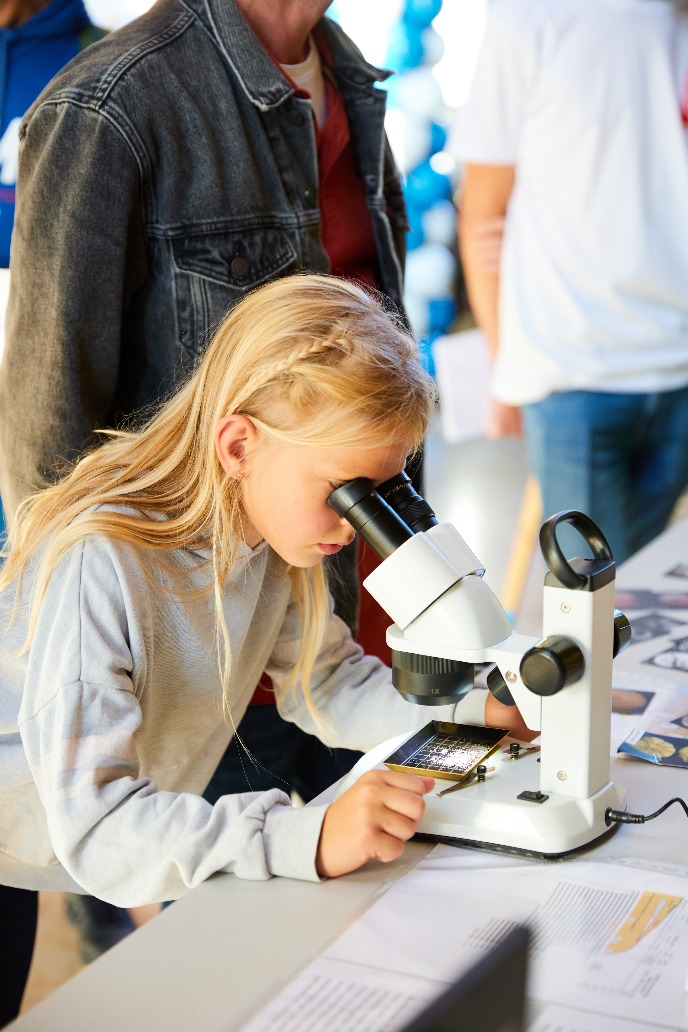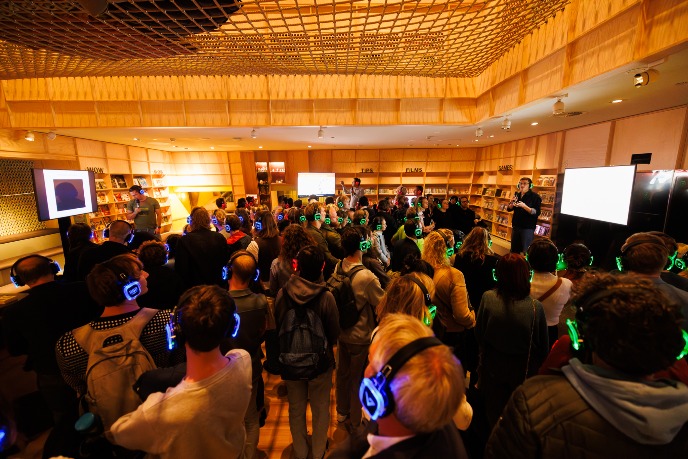Science festival experiences: ‘Finding a good metaphor is extremely important’
The European Researchers' Night (ERN) and Zpannend Zernike (ZZ) are science festivals where researchers interact with a broad audience. ERN is aimed at adults, while ZZ is designed for children. In this two-part series, UG researchers talk about their experiences last year. ‘I can definitely recommend other researchers to participate in these events.’
Text: Jelle Posthuma

Zpannend Zernike and ERN offer scientists a great opportunity to explore beyond traditional scientific paths. Many researchers do not reach out to a wide audience on a daily basis. Francesca Bulian, a geologist and postdoc at the UG, participated in Zpannend Zernike last year. 'I genuinely enjoyed the event. As a micropaleontologist, I specialise in very small fossils. It was surprising and refreshing to see how many people were interested in my work. Normally you ‘just’ do your scientific work, and are not really engaged with the outside world.'
During Zpannend Zernike, Bulian spoke about extraordinary fossils in the floor of the building that houses the House of Connections. These prehistoric creatures lived in the sea millions of years ago. Today, these ‘urban fossils’ can still be seen in floors, facades and stairs of buildings. ‘People said they would look at buildings and materials differently in the future, which was obviously nice to hear. My microscope, which allowed people to study microfossils, helped to make the subject accessible. And the children were actually enthusiastic about everything,' the postdoc laughs.
Metaphor
According to Bulian, it is important to look for a suitable metaphor to communicate about scientific work. 'I used the metaphor of a detective to explain my work. As paleontologists, we study the past like detectives and look for clues in the ground. The children could go on a scavenger hunt, looking for clues like detectives themselves.' The researcher hopes the children were inspired. ‘Who knows, maybe they will buy a book about fossils and perhaps they want to go to university in the future.'
Jesca de Jager, PhD at the UMCG, also recognises the importance of metaphors. She participated in the European Researchers' Night festival last year. 'In preparation, I thought a lot about good metaphors, because I didn't really want to use jargon. A good metaphor is extremely important. At the same time, it is difficult to get over all the scientific nuances. I took a science communication workshop from the UMCG and I practiced at home with my mother and my partner. While they are science enthusiasts, they are not experts in neurobiology. Therefore, they were a good practice audience.'

Science Battle
De Jager's research focuses on neuroplasticity, or the ability of the brain to generate new structures and connections. During ERN, the PhD candidate discussed the impact of mental disorders, such as severe depression or schizophrenia, and the potential positive effects of treatment with psychedelics. De Jager participated in a Science Battle during the festival, where researchers were given seven minutes to talk about their research. The audience could use headphones to choose which researcher they wanted to listen to.
Neuroplasticity is among others about connections in the brain, De Jager continues. ‘Babies have an enormous number of these connections. As we learn what is important, we eliminate some connections, while others get stronger.' The PhD candidate likens it to the paths in a forest, a metaphor she also used during the ERN. ‘Some paths are frequently trodden, while others are pretty much dense. With depression, the forest becomes very dark and you keep walking on the same paths, sustaining negative feelings. We can see from scans that people with mental disorders actually often have (much) fewer connections.’
Research shows that psychedelics can have a positive effect on patients with depression. The substances in psychedelics stimulate the brain to make new connections. A similar effect can be seen in electroshock therapy. ‘You shake up the forest as it were, creating new pathways.’ However, the influence of psychedelics needs further investigation, the PhD candidate stresses. ‘There is a lot of interest among patients who are very sick to participate in such research: many people see it as a last resort.’
Great opportunity
The audience during ERN responded positively to the story. In fact, De Jager managed to win the ‘Science Battle’. 'Three people came up to me afterwards to ask questions about the research. The use of psychedelics in mental disorders is a ‘hot topic’. I think it is important to share where we are with our research. Moreover, it is important to talk openly about mental disorders. It took me quite some time to prepare my presentation properly, but I can definitely recommend other researchers to participate in the event.'
Bulian agrees. ‘As a researcher, you do to some extent live in an academic bubble. Many of my friends work in the scientific world. This means there is a certain risk of losing sight of the rest of society. Events like Zpannend Zernike offer a great opportunity to show what we are doing as scientists.'
You can join the 2025 edition of the fall science festivals by 1 May by registering via this link.
| Last modified: | 20 March 2025 09.55 a.m. |
More news
-
24 March 2025
UG 28th in World's Most International Universities 2025 rankings
The University of Groningen has been ranked 28th in the World's Most International Universities 2025 by Times Higher Education. With this, the UG leaves behind institutions such as MIT and Harvard. The 28th place marks an increase of five places: in...
-
05 March 2025
Women in Science
The UG celebrates International Women’s Day with a special photo series: Women in Science.
-
16 December 2024
Jouke de Vries: ‘The University will have to be flexible’
2024 was a festive year for the University of Groningen. In this podcast, Jouke de Vries, the chair of the Executive Board, looks back.

